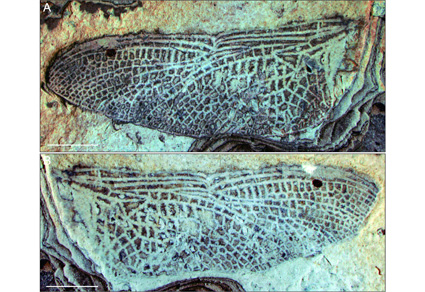Abstract
A new hemeroscopid dragonfly, Parahemeroscopus jiuquanensis gen. et sp. nov., is described from the Lower Cretaceous Zhonggou Formation of the Jiuquan Basin, northwestern China. Parahemeroscopus gen. nov. has the mixed characters of the hemeroscopid genera Hemeroscopus Pritykina, 1977 and Abrohemeroscopus Ren, Liu & Cheng, 2003, and probably represents a transitional dragonfly from Abrohemeroscopus to Hemeroscopus. The new finding not only adds to the diversity of the Hemeroscopidae Pritykina, 1977, but also provides clues for revealing the early evolution of the hemeroscopid dragonflies.
References
- Bechly, G. (1996) Morphologische Untersuchungen am Flügelgeäder der rezenten Libellen und deren Stammgruppenvertreter (Insecta; Pterygota; Odonata), unter besonderer Berücksichtigung der Phylogenetischen Systematik und des Journal Pre-proof Grundplanes der Odonata. Petalura, 2, 1–402.
- Bechly, G., Nel, A., Martínez-Delclòs, X. & Fleck, G. (1998) Four new dragonflies from the Upper Jurassic of Germany and the Lower Cretaceous of Mongolia (Anisoptera: Hemeroscopidae, Sonidae, and Proterogomphidae). Odonatologica, 27, 149–187.
- Bechly, G. & Ueda, K. (2002) The first fossil record and first New World record for the dragonfly clade Chlorogomphida (Insecta: Odonata: Anisoptera: Araripechlorogomphidae n. fam.) from the Crato Limestone (Lower Cretaceous, Brazil). Stuttgarter Beiträge zur Naturkunde, Series B, 328, 1–11.
- Chang, S., Zhang, H., Renne, P.R. & Fang, Y. (2009) A high-precision 40Ar/39Ar age for the Jehol Biota. Palaeogeography, Palaeoclimatology, Palaeoecology, 280, 94–104. https://doi.org/10.1016/j.palaeo.2009.06.021
- Du, B., Zhang, M., Sun, B., Li, A., Zhang, J., Yan, D., Xie, S. & Wu, J. (2021) An exceptionally well preserved herbaceous eudicot from the Early Cretaceous (late Aptian–early Albian) of Northwest China. National Science Review, 8, nwab084. https://doi.org/10.1093/nsr/nwab084
- Fabricius, J.C. (1793) Entomologia systematica emendata et aucta, secundum classes, ordines, genera, species, adjectis synonymis, locis, observationibus, descriptionibus. Vol. 2. C G Proft, Hafniae [Copenhagen], 519 pp. https://doi.org/10.5962/bhl.title.125869
- Nel, A., Martínez-Delclòs, X., Paicheler, J.C. & Henrotay, M. (1993) Les ‘Anisozygoptera’ fossiles. Phylogénie et classification (Odonata). Martinia, Numéro Hors Série, 3, 1–311.
- Pritykina, L.N. (1977) New dragonflies from Lower Cretaceous deposits of Transbaikalia and Mongolia. In: Barsbora, R. (Ed.), Mesozoic and Cenozoic Faunas, Floras and Biostratigraphy of Mongolia. Nauka Press, Moscow, pp. 1–96. [in Russian]
- Ren, D., Lu, L., Guo, Z. & Ji, S. (1995) Faunae and stratigraphy of the Jurassice Cretaceous in Beijing and adjacent areas. Seismic Publishing House, Beijing, 222 pp. [in Chinese with English summary]
- Ren, D., Liu, J. & Cheng, X. (2003) A new hemeroscopid dragonfly from the Lower Cretaceous of northeast China (Odonata: Hemeroscopidae). Acta Entomologica Sinica, 46 (5), 622–628.
- Riek, E.F. (1976) A new collection of insects from the Upper Triassic of South Africa. Annals of the Natal Museum, 22, 791–820.
- Riek, E.F. & Kukalová-Peck, J. (1984) A new interpretation of dragonfly wing venation based upon Early Carboniferous fossils from Argentina (Insecta: Odonatoidea) and basic characters states in pterygote wings. Canadian Journal of Zoology, 62, 1150–1166. https://doi.org/10.1139/z84-166
- Selys-Longchamps, E. de (1854) Monographie des Calopterygines. Mémoires de la Société royale des Sciences de Liège, 9, i–xi + 1–291. https://doi.org/10.5962/bhl.title.60461
- Ueda, K., Kim, T. & Aoki, T. (2005) A new record of an Early Cretaceous fossil dragonfly from Korea. Bulletin Kitakyushu Museum of Natural History & Human History, 3, 145–152.
- Vrsanský, P. (2008) New blattarians and a review of dictyopteran assemblages from the Lower Cretaceous of Mongolia. Acta Palaeontologica Polonica, 53 (1), 129–136. https://doi.org/10.4202/app.2008.0109
- Wang, H., Zheng, D., Lei, X., Zhang, Q., Ren, X., Wang, B., Fang, Y., Jarzembowski, E.A. & Zhang, H. (2017) A new species of Chifengiinae (Orthoptera: Prophalangopsidae) from the Lower Cretaceous Zhonggou Formation of the Jiuquan Basin, Northwest China. Cretaceous Research, 73, 60–64. https://doi.org/10.1016/j.cretres.2017.01.006
- Zhang, M., Ji, L., Du, B., Dai, S. & Hou, X. (2015) Palynology of the Early Cretaceous Hanxia Section in the Jiuquan Basin, Northwest China: the discovery of diverse early angiosperm pollen and paleoclimatic significance. Palaeogeography, Palaeoclimatology, Palaeoecology, 440, 297–306. https://doi.org/10.1016/j.palaeo.2015.09.010
- Zhang, J., Dong, L., Du, B., Li, A., Lei, X., Zhang, M., Wang, S., Ma, G. & Hui, J. (2023) First fossil evidence for a new frog from the Early Cretaceous of the Jiuquan Basin, Gansu Province, northwestern China. Journal of Systematic Palaeontology, 21 (1), 2183146. https://doi.org/10.1080/14772019.2023.2183146
- Zheng, D., Zhang, H., Zhang, Q., Li, S., Wang, H., Fang, Y., Liu, Q., Jarzembowski, E.A., Evgeny, Y. & Wang, B. (2015) The discovery of an Early Cretaceous dragonfly Hemeroscopus baissicus Pritykina, 1977 (Hemeroscopidae) in Jiuquan, Northwest China, and its stratigraphic implications. Cretaceous Research, 52, 316–322. https://doi.org/10.1016/j.cretres.2014.02.020
- Zheng, D., Zhang, H., Wang, B. & Chang, S.-C. (2017) A new species of damsel-dragonfly (Odonata: Stenophlebiidae: Cretastenophlebia) from the Lower Cretaceous of the Jiuquan Basin, northwestern China. Earth and Environmental Science Transactions of the Royal Society of Edinburgh, 107, 185–189. https://doi.org/10.1017/S1755691017000093
- Zheng, D., Wang, H., Li, S., Wang, B., Jarzembowski, E.A., Dong, C., Fang, Y., Teng, X., Yu, T., Yang, L. & Zhang, H. (2021) Synthesis of a chrono- and biostratigraphical framework for the Lower Cretaceous of Jiuquan, NW China: implications for major evolutionary events. Earth-Science Reviews, 213, 103474. https://doi.org/10.1016/j.earscirev.2020.103474


